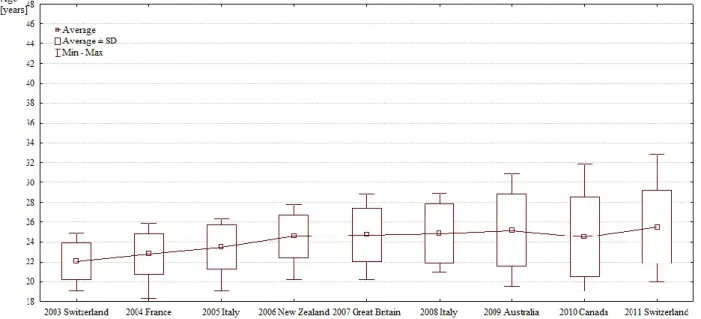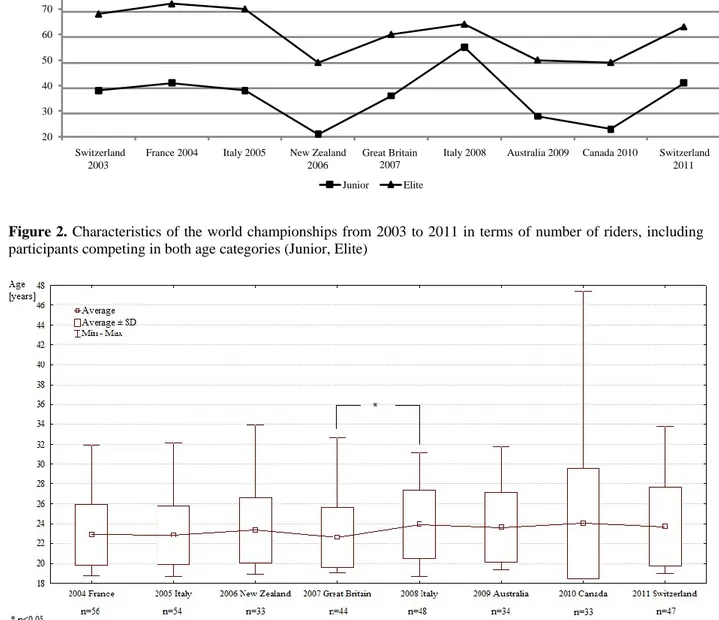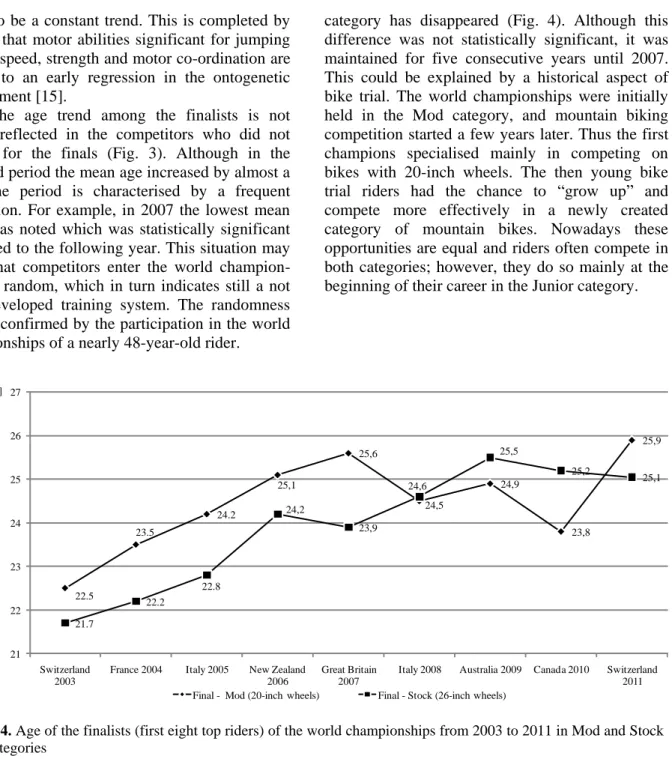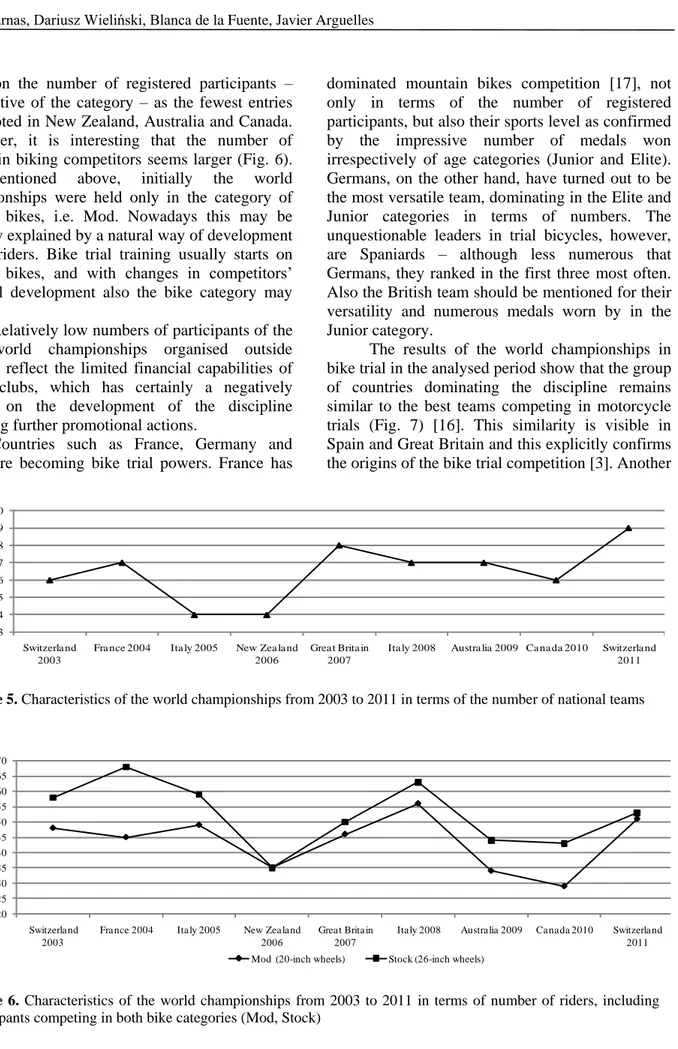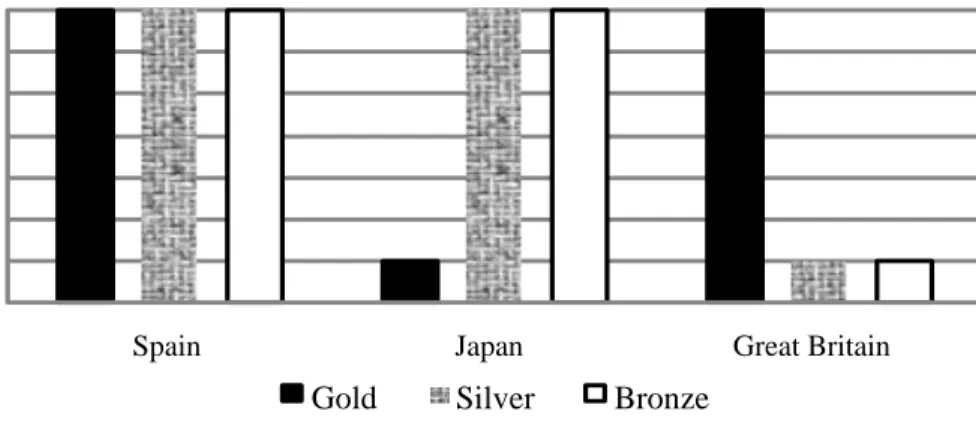297
REVIEW ARTICLE
JACEK TARNAS1, DARIUSZ WIELIŃSKI1, BLANCA DE LA FUENTE2, JAVIER ARGUELLES2 1
University School of Physical Education in Poznań, Poland 2
Sierra Nevada High Altitude Training Center, Sierra Nevada, Spain
BIKE TRIAL – CHARACTERISATION OF THE EVENT IN VIEW OF THE UCI
WORLD CHAMPIONSHIPS FROM 2003 TO 2011
Key words: bike trial, age, world championships.
ABSTRACT
Bike trial is a relatively young cycling competition originating from motor sport. The study provides an analysis of bike trial on the basis of results from the UCI (Union Cycliste Internationale) world championships from 2003 to 2011. The starting point for the analysis was the data from 2003 related to sporting experience, forms of training and other issues. The competitors’ age, numerical characteristics of national teams and their sports level were also analysed. The collected data were compared with data from the FIM motocycle trial world championships from 1997 to 2011. The age of bike trial finalists has been stabilised in recent years, which indicates the emergence of rules necessary for the training process. Similarly, the numbers of bike riders and national teams tend to remain constant. Nowadays top bike trial riders come from France, Germany, Spain and the United Kingdom, which to a large extent coincides with the popularity of motor trial in these countries. Bike trial is still an insufficiently described discipline and its further development requires a close study of the training process.
INTRODUCTION
Bike trial is a relatively young sport discipline, which is a version of mountain biking [3]. It originates from motorbiking sport developed in Great Britain. The first bike trial competitions are attributed to Spain. Bearing in mind the traditions related to the development of the above disciplines we may assume that these countries significantly affect the current level of trial, both on motorbikes and on bicycles. However, other countries have also begun to contribute to the development of bike trial. Examples of such
contributions can be the successes of Polish riders winning individual world champion and vice-champion titles as well as top places in team competition [11].
Data on championship level competitions provide reliable information about the development of sports disciplines. At present bike trial aspires to become an Olympic discipline, therefore, the most important goal for top bike trial competitors is winning the world champion title. The world associations which organize world championships and gather the best competitors include the UCI (Union Cycliste Internationale – the International
Correspondence should be addressed to: Jacek Tarnas, Department of Various Sports and Camps Organisation,
298
Cycling Union) and the BIU (Bike Trial International Union). The former covers all cycling disciplines, whereas the latter focuses on bike trial only. The UCI mountain biking world champion-ships have been watched by an increasing number of viewers.
The few existing studies on bike trial [11, 12, 13] have not attempted to describe such aspects of bike trial world championships as age of top riders, their nationalities or popularity of the event by the number of the competitors. These aspects seem significant for further development of bike trial. Data on all these aspects may contribute to the preparation of the best strategies for development of the sport, which require a complex analysis of changes in the bike trial training process [14].
BIKE TRIAL TRAINING IN 2003 Bike trial is considered to be technically the most difficult cycling event. Qualifying for the finals in a domestic competition requires skills trained for many years. Only then is a bike rider able to safely negotiate the course obstacles the size of which often exceeds the height of the bike. It may be assumed that these skills must be gained in an organised and planned training system. However, a study carried out in 2003 on bike trial competitors did not confirm it [10]. Out of twenty one surveyed participants of the 2003 World Championships in Lugano, who accounted for 38% of all participants in the bike trial world championships, only three declared that they had taken part in training organised by a club; seven trained in unorganised groups and eleven declared individual training. This can be an indication of the relatively early stage in the development of the discipline, still without a solid sports club basis. The respondents also pointed to problems hindering the training process, primarily to the lack of funding. In spite of the bike trial being an attractive show, the low popularity of the discipline makes it difficult to find sponsors.
The time which has elapsed since 2003 allows us to assume that today bike trial training is on a much higher, professional level. Concerns may only be raised by the fact that there are no detailed empirical studies in this area. There have been no publications to date on the bike trial training process. In 2004 a book was published that described the technique of negotiating course
obstacles co-authored by Hans Rey, one of the bike trial forerunners; however, it merely described the basic technical elements. The lack of com-prehensive description of a system of technical exercises, and the emergence of new, different ways of negotiating obstacles on a bicycle seem to diminish the quality of this publication for the training process.
TRAINING EXPERIENCE OF TOP BIKE TRIAL COMPETITORS
The level of popularity of this difficult sport may also be determined by the time that needs to be devoted to succeed in bike trial. Depending on a bike trial event, the training process can take from eight to ten years [8]. The training experience of the best bike trial competitors, amounting to more than 11 years on the average [10] shows that bike trial riders pay for their success with long and hard work. Sachnowski and Sozański [7] find that a fast competitive career is characteristic for disciplines based on special abilities, which become fully developed during adolescence. They provide examples of artistic gymnastics and acrobatic gymnastics. On the other hand, many years of training are required to master the vast number of various techniques and special skills in fencing [2]. Fencers, as opposed to gymnasts, must measure up to constantly changing situations, face new challenges all the time and respond quickly. Although the competitive conditions of fencers differ widely from negotiating obstacles on a bike trial course, it seems that the multitude of used sports techniques may be a common denominator between the sports. The essence of bike trial is negotiating unique sets of various obstacles which present a different task each time. Its appropriate solution requires many years of experience allowing implementing optimal techniques and tactics, taking into account weather conditions and the rider’s current results. Moreover, the obstacles encountered at the world championships sometimes require specific technical elements mastered by few competitors. The bike trial training process which lasts many years is determined among other things by a rider’s individual features which affect the speed of acquisition of technical skills [6]. According to Czabański [1], the growing potential of motor experience makes it easier to acquire new activities. We may then believe that experienced
299 riders adapt more quickly to varied conditions of
bike trail. Their motor potential allows them to perform unusual acrobatic maneuvers, usually beyond the reach of less experienced riders. Similar observations were made among surfers [5]. In surfing, champion titles go to those who can perform the most difficult technical elements without an error in constantly changing conditions of the water environment. The authors emphasize that meeting these requirements requires undertaking long training.
AGE OF ACHIEVING BEST RESULTS IN BIKE TRIAL
A factor related to training experience and determination of a sports level is the age of achieving best results [9]. The analysis of the age of all world championships finalists from 2003 to 2007 in the Elite category revealed a statistically non-significant but stable increase (Fig. 1). This may indicate a dynamic stage in the development of the discipline in question at the time. The constantly growing age of bike trial finalists may be explained by insignificant yearly changes in the teams, therefore the noted age of achieving the best results increases in a relatively constant group of best competitors. This is confirmed by different groups of medalists defending their podium ranks
for a few consecutive years in some cases [17]. Among the trial bikers, Benito Ros Charral was on the podium every year, Marco Hösel four times, and Rafał Kumorowski three times. In mountain bike events Vincent Hermance won seven world championship medals, Kenny Belaey six, Gilles Coustellier four and Marc Caisso three. A similar situation, but to a smaller extent, may be noted in juniors where there are many riders who took a place on the podium at least twice in a row [17]. Moreover, in this category a high degree of participants’ versatility was noted. Taking into account similarities in the riding technique on trial and mountain bikes it may be assumed that competition in both bike categories is a strategically important element in competition between national teams.
From 2003 to 2011 at least one rider won a world championship medal in both bike categories, which is very rare in the Elite category. Probably a smaller number of Juniors compared to Elite riders feature a low training level in the first group and as a result larger possibilities of succeeding in trial and mountain bikes. This may also indicate that the effort put into effective struggle for medal position in the oldest category must be concentrated on one bike category. It should be emphasised here that this is an unusual situation in sports competition, where every year the number of the oldest riders in the Elite category significantly
300
exceeds the number of juniors (Fig. 2). Therefore, at the world championships there can be bike riders who compete in the oldest category without having competed at a junior age. This points indirectly to a poorly developed training system and remains in line with the results concerning the training process from 2003 [10].
Going back to the analysis of the finalists’ age, we may note its clear stabilisation in the last five years (Fig. 1). This is significant information for rational planning of the training process. An optimal age range of champions was 24 to 25 years and this could be the indication of the complete “maturation” process of the discipline.
The optimal age for achieving best sports results in bicycle trial is similar for track and field jumpers [4]. The nature of the compared sports seems identical as in bicycle trial obstacles are most often overcome by jumping. The height of the obstacles in the Elite category can be close to 1.8 m [17]. It should also be added that the data on the age of the best field and track athletes comes from world championships records from the last 29 years. Thus, they may be a reliable source of information on the age of achieving the best results in disciplines based on elements of jumping. Thus the stabilisation of the age of bike trial world championship finalists noted in the last three years
20 30 40 50 60 70 80 Switzerland 2003
France 2004 Italy 2005 New Zealand 2006
Great Britain 2007
Italy 2008 Australia 2009 Canada 2010 Switzerland 2011
Junior Elite
[n]
Figure 2. Characteristics of the world championships from 2003 to 2011 in terms of number of riders, including
participants competing in both age categories (Junior, Elite)
301 seems to be a constant trend. This is completed by
the fact that motor abilities significant for jumping such as speed, strength and motor co-ordination are subject to an early regression in the ontogenetic development [15].
The age trend among the finalists is not clearly reflected in the competitors who did not qualify for the finals (Fig. 3). Although in the analysed period the mean age increased by almost a year, the period is characterised by a frequent fluctuation. For example, in 2007 the lowest mean value was noted which was statistically significant compared to the following year. This situation may prove that competitors enter the world champion-ships at random, which in turn indicates still a not fully developed training system. The randomness may be confirmed by the participation in the world championships of a nearly 48-year-old rider.
It should be added that from 2008 to 2011 the age uniformity of the top bike riders (finalists) was lowered, which reflected higher standard deviation than the one noted in the previous years. This results from the changes in the relatively constant early group of top competitors which has been extended now to include younger talented riders. It should also be noted that with increasing standard deviation in the consecutive years the trend of higher age of the finalists in the Mod bike
category has disappeared (Fig. 4). Although this difference was not statistically significant, it was maintained for five consecutive years until 2007. This could be explained by a historical aspect of bike trial. The world championships were initially held in the Mod category, and mountain biking competition started a few years later. Thus the first champions specialised mainly in competing on bikes with 20-inch wheels. The then young bike trial riders had the chance to “grow up” and compete more effectively in a newly created category of mountain bikes. Nowadays these opportunities are equal and riders often compete in both categories; however, they do so mainly at the beginning of their career in the Junior category.
BIKE TRIAL IN VIEW TO INTERNATIONAL COMPETITION
The stabilisation of bike trial development also includes a relatively stable number of national teams competing at the world championships (Fig. 5) and the number of entered participants (Fig. 6) [17]. It could be observed that the distance of the host country organising the world championship from Europe has an unquestionable 22.5 23.5 24.2 25,1 25,6 24,5 24,9 23,8 25,9 21.7 22.2 22.8 24,2 23,9 24,6 25,5 25,2 25,1 21 22 23 24 25 26 27 Switzerland 2003
France 2004 Italy 2005 New Zealand 2006
Great Britain 2007
Italy 2008 Australia 2009 Canada 2010 Switzerland 2011 Age [years]
Final - Mod (20-inch wheels) Final - Stock (26-inch wheels)
Figure 4. Age of the finalists (first eight top riders) of the world championships from 2003 to 2011 in Mod and Stock
302
effect on the number of registered participants – irrespective of the category – as the fewest entries were noted in New Zealand, Australia and Canada. Moreover, it is interesting that the number of mountain biking competitors seems larger (Fig. 6). As mentioned above, initially the world championships were held only in the category of smaller bikes, i.e. Mod. Nowadays this may be partially explained by a natural way of development of the riders. Bike trial training usually starts on smaller bikes, and with changes in competitors’ physical development also the bike category may change.
Relatively low numbers of participants of the UCI world championships organised outside Europe, reflect the limited financial capabilities of sports clubs, which has certainly a negatively impact on the development of the discipline requiring further promotional actions.
Countries such as France, Germany and Spain are becoming bike trial powers. France has
dominated mountain bikes competition [17], not only in terms of the number of registered participants, but also their sports level as confirmed by the impressive number of medals won irrespectively of age categories (Junior and Elite). Germans, on the other hand, have turned out to be the most versatile team, dominating in the Elite and Junior categories in terms of numbers. The unquestionable leaders in trial bicycles, however, are Spaniards – although less numerous that Germans, they ranked in the first three most often. Also the British team should be mentioned for their versatility and numerous medals worn by in the Junior category.
The results of the world championships in bike trial in the analysed period show that the group of countries dominating the discipline remains similar to the best teams competing in motorcycle trials (Fig. 7) [16]. This similarity is visible in Spain and Great Britain and this explicitly confirms the origins of the bike trial competition [3]. Another
13 14 15 16 17 18 19 20 Switzerla nd 2003
Fra nce 2004 Ita ly 2005 New Zea la nd 2006
Grea t Brita in 2007
Ita ly 2008 Austra lia 2009 Ca na da 2010 Switzerla nd 2011
[n]
Figure 5. Characteristics of the world championships from 2003 to 2011 in terms of the number of national teams
20 25 30 35 40 45 50 55 60 65 70 Switzerla nd 2003
Fra nce 2004 Ita ly 2005 New Zea la nd 2006
Grea t Brita in 2007
Ita ly 2008 Austra lia 2009 Ca na da 2010 Switzerla nd 2011 Mod (20-inch wheels) Stock (26-inch wheels)
[n]
Figure 6. Characteristics of the world championships from 2003 to 2011 in terms of number of riders, including
303 common feature is the fact that in both sports often
the same, very talented people take their places on the podium. Since 1997 Dougie Lampkin (Great Britain) has been a seven-time outdoor FIM Trial World Champion. Only Jordi Tarres (Spain) did it before. Toni Bou (Spain) has been invincible for the last 5 years. This is indicative of the high degree of difficulty of the described disciplines – in which the highest level is reached by few – but also the influence of many years of trial tradition. It should be also added that this tradition seems to be supported by indirect factors, such as climate, landform features, and the level of wealth of the society.
To sum up, a country with the largest number of medals in the period in question is Spain (Fig. 8). In the medal classification only Japan and Great Britain do really count. Taking into consideration the popularity of motor trial in Japan and Italy –
expressed by the number of registered world championships, it may be assumed that the level of development of the automotive industry may also play a significant part in a given country.
It can be stated that the development and popularity of bike trial should be associated with a few countries, often with motorcycling traditions. A high sports level presented by bike riders from France, Spain, Germany and Great Britain makes Europe the hub of the discipline and of knowledge necessary for its further development. This does not mean that bike trial enjoys great popularity only in countries with the best riders. The vast number of trial fans on all continents marks their presence in a large number of Internet sites devoted to the sport. Moreover, it should be emphasised that apart from competitions there are other, probably more effective, forms of promoting unconventional cycling skills. For example, riding up stairs in the 130 91 66 39 30 9 6 5 4 4 1 1 1
Spa in Ja pa n Grea t Brita in Ita ly Fra nce Finla nd Pola nd Belgium Czech RepublicGerma ny Norwa y RPA USA
Figure 7. Characteristics of the FIM (Fédération Internationale de Motocyclisme) motorcycle trial world
championships from 1997 to 2011 in terms of the number of rider entries from participating countries
0 1 2 3 4 5 6 7
Spain Japan Great Britain
Gold Silver Bronze [n]
Figure 8. Characteristics of the FIM (Fédération Internationale de Motocyclisme) motorcycle trial world
304
world’s tallest buildings as part of Guinness record setting, watched by thousands of spectators all over the world. Furthermore, the amazing trial riding skills of Danny MacAskill have been watched on the Internet more than 22 million times.
The problem, and at the same time, unused potential of bike trial is still the small number of sports clubs and coaches able to develop appropriate training systems. The development of bike trial definitely requires further research in the area of training.
REFERENCES
[1] Czabański B., Wybrane zagadnienia uczenia się i na-uczania techniki sportowej (Selected problems in learning and teaching sports technique), Wydaw-nictwo AWF we Wrocławiu, Wrocław 1998. [2] Czajkowski Z., Wiek a mistrzowskie wyniki
szer-mierzy (Age and championship performance of fencers), Sport Wyczynowy, 1988, 12, pp. 19-23. [3] Lipoński W., Encyklopedia sportów świata (World
Sports Encyclopedia), Oficyna Wydawnicza Atena, Poznań 2006.
[4] Marcinów R., Nawarecki D., Tataruch R., Różne aspekty wieku mistrzostwa sportowego w skoku w dal mężczyzn (Various aspects of sports champion-ship age in men’s long jump) (in:) A. Kuder, K. Per-kowski, D. Śledziewski, eds., Proces doskonalenia treningu i walki sportowej (Process of mastering of training and sports competition), AWF Warszawa, 2006, vol. 3: 43-38.
[5] Mendez-Villanueva A., Bishop D., Physiological aspect of surfboard riding performance, Sports
Medicine, 2005, 35 (1), pp. 55-70.
[6] Płatonow W.N., Struktura wieloletniego treningu (The structure of long-term training), Sport
Wyczy-nowy, 1990, 1-2, pp. 7-12.
[7] Sachnowski K., Sozański H., Rozwój kariery sportowej, struktura wieloletniego procesu trenin-gowego (The development of sports career, structure of long-term training process), (in:) W.N. Płatonow, H. Sozański, eds., Optymalizacja struktury treningu sportowego (Optimisation of sports training structure), RCMSKFiS, Warszawa 1991.
[8] Sozański H., Podstawowe zasady programowania szkolenia sportowego dzieci i młodzieży (Basic principles of programming sports training of children and adolescents), (in:) H. Sozański, ed., Podstawy teorii treningu sportowego, COS, Warsza-wa 1999a.
[9] Sozański H., Model mistrzostwa sportowego jako zbiór wytycznych długofalowego planowania (The model of sports championship as a set of guidelines of long-term planning) (in:) H. Sozański, ed., Podstawy teorii treningu sportowego (Rudiments of sports training theory), COS, Warszawa 1999b. [10] Tarnas J., Morfologiczne i motoryczne
uwarunko-wania poziomu sportowego zawodników uprawia-jących trial rowerowy (Morphological and motor determinants of the sports level of competitors in bike trial), doctoral dissertation, AWF, Poznań 2007.
[11] Tarnas J., Bednarz A., Trial rowerowy – szkic do portretu (Bike trial – an outline), Sport Wyczynowy, 2008, 4-6, pp. 165-172.
[12] Tarnas J., Wieliński D., Types of body build of bike trial competitors, Studies in Physical Culture and
Tourism, 2005, vol. 12, no. 2, pp. 55-64.
[13] Rey H., Rögner T., No way. Bike trial tricks. Für alle Mountainbiker. Delius Klasing, Germany, 2004. [14] Ważny Z., Sport wczoraj, dziś, jutro w świetle badań wyników sportowych (Sport yesterday, today, tomorrow in the light of studies of sports results),
Sport Wyczynowy, 2001, 11-12, pp. 5-13.
[15] Wolański N., Możliwości organizmu ludzkiego a środowisko (Capacity of the human body and the environment), Medicina Sportiva, 1999, vol. 3, 3, pp. 161-175.
[16] www.fim-live.com/en [17] www.uci.ch
